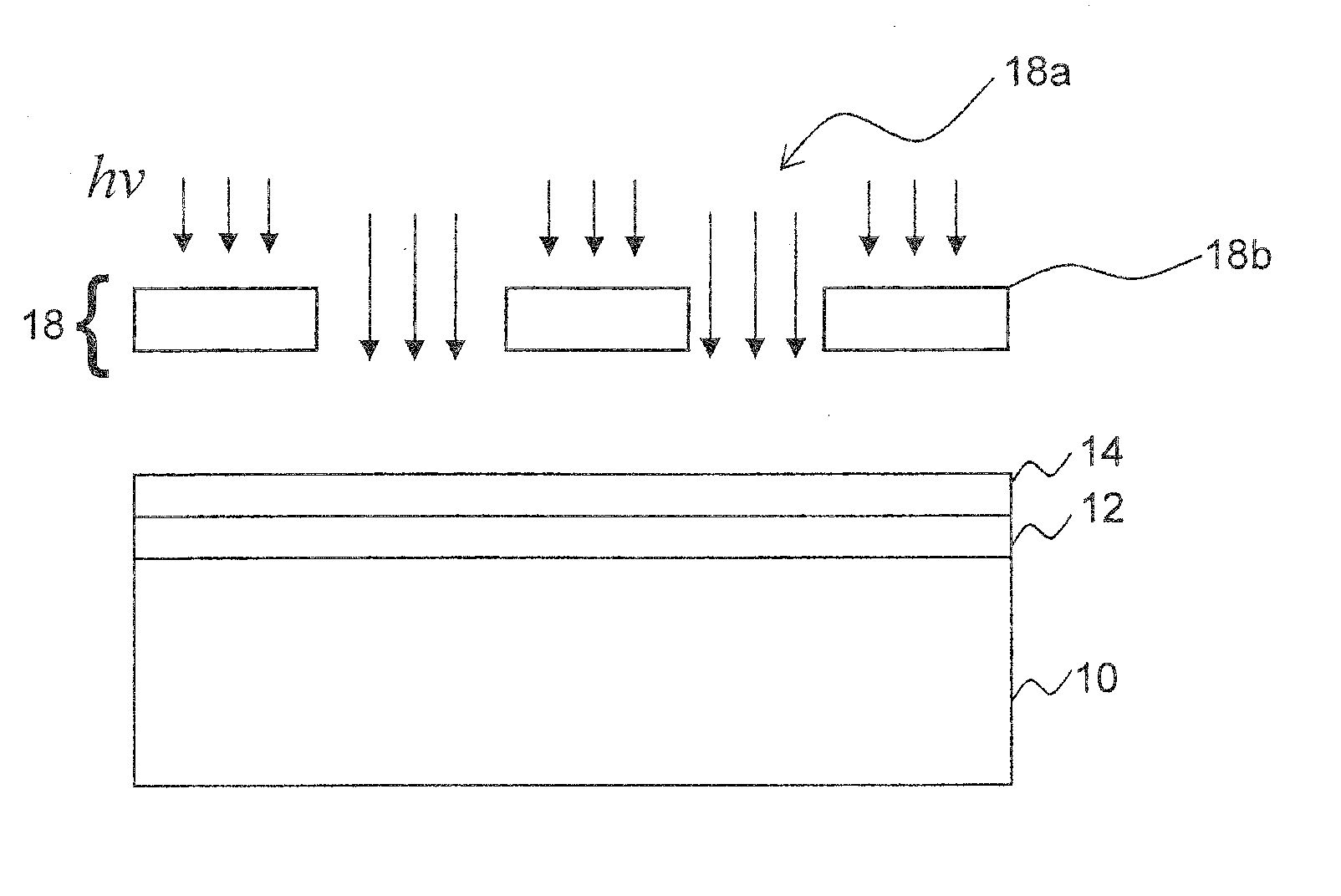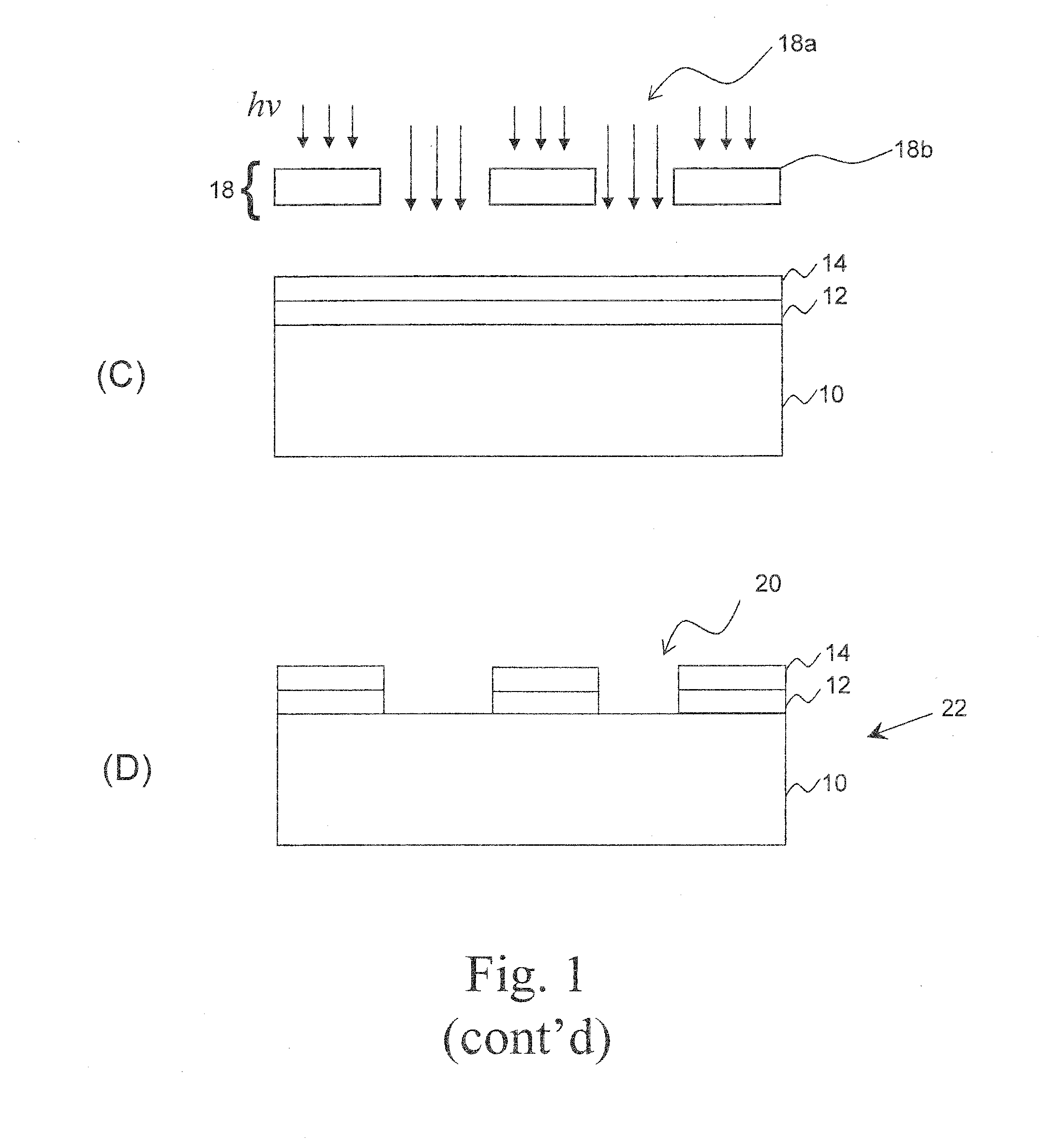Acid-sensitive, developer-soluble bottom Anti-reflective coatings
a developer-soluble, anti-reflective coating technology, applied in the direction of photosensitive materials, semiconductor/solid-state device details, instruments, etc., can solve the problems that the developer-soluble bottom anti-reflective coating does not always provide the resolution achievable, and the use of dyed resists with top anti-reflective coatings is not sufficient for 45-, 32-, and 22-nm node implant layers
- Summary
- Abstract
- Description
- Claims
- Application Information
AI Technical Summary
Problems solved by technology
Method used
Image
Examples
example 1
Terpolymer I Synthesis and Precipitation Thereof
[0068]
[0069]In this procedure, a terpolymer was synthesized using 12.9 mol % IPM, methacrylic acid, and styrene, followed by precipitation. A 500-ml three-necked flask equipped with magnetic stirring bar and thermometer was charged with 9.08 g (105.5 mmol) of methacrylic acid (Sigma-Aldrich, St. Louis, Mo.), 12.38 g (118.9 mmol) of styrene (Sigma-Aldrich. St. Louis, Mo.), 8.71 g ((33.2 mmol) of Adamantate® X-M-105 (IPM; Idemitsu Kosan Co., Ltd., Tokyo, Japan), and 203.72 g of PGME. The mixture was stirred for 5 minutes at room temperature to produce a solution. A dropping funnel with a nitrogen inlet adapter and a condenser with a nitrogen outlet adapter were then attached to the flask.
[0070]A clear 125-ml Nalgene bottle was charged with 0.68 g (4.14 mmol) of 2,2′-azobisisobutyronitrile (AIBN; Sigma-Aldrich, St. Louis, Mo.) and 67.63 g of PGME. The mixture was tumbled at room temperature for 0.64 hours to produce a solution. The droppi...
example 2
Preparation of a Bottom Anti-Reflective Coating Using Terpolymer I
[0072]In this procedure, a bottom anti-reflective coating was prepared using terpolymer I (IPM), from Example 1 above, along with a PAG, and a quencher. A 250-ml amber Nalgene bottle was charged with 0.718 g of an in-house vinyl ether crosslinker (see Example 27), 2.423 g of terpolymer I, 156.1861 g of PGME, and 39.36 g of PGMEA. The mixture was tumbled at room temperature for 15.2 hours. Next, 1296 g of a 1% quencher (1-Boc-4-hydroxypiperidine; Sigma-Aldrich, St. Louis, Mo.) in PGME solution was added, followed by 0.0423 g of CGI TPS-Cl (Ciba, Tarrytown, N.Y.). The bottle was then tumbled at room temperature overnight, and its contents twice filtered through a 0.1-μm end-point filter into four 60-ml amber Nalgene bottles.
[0073]Various properties of the resulting bottom anti-reflective coating were then tested. For the optical and film property tests, the bottom anti-reflective coating was first spin applied to silico...
example 3
Preparation of a PAG-Less Bottom Anti-Reflective Coating Using Terpolymer I
[0079]In this procedure, a bottom anti-reflective coating was prepared using terpolymer I (IPM), without a PAG or quencher. A 125-ml amber Nalgene bottle was charged with 1.2156 g of terpolymer I, 0.359 g of the crosslinker from Example 27, 74.309 g of PGME, and 19.679 g of PGMEA. The mixture was tumbled at room temperature overnight, and then end-point filtered using a 0.1-μm filter. The resulting bottom anti-reflective coating was spin applied to a silicon wafer at either: a) 1,500 rpm for 30 or 60 seconds or b) 2,738 rpm for 30 or 60 seconds, each followed by baking at 160° C. for 60 seconds. Spin parameter a) gave 54-55 nm of thermoset bottom anti-reflective coating, while spin parameter b) gave 38 nm of thermoset bottom anti-reflective coating. Next, 193-nm lithography was carried out as described above in Example 2 using covering resist ARX3001JN at a 195-nm thickness. The SEM photos (prepared using a L...
PUM
| Property | Measurement | Unit |
|---|---|---|
| Fraction | aaaaa | aaaaa |
| Fraction | aaaaa | aaaaa |
| Fraction | aaaaa | aaaaa |
Abstract
Description
Claims
Application Information
 Login to View More
Login to View More - R&D
- Intellectual Property
- Life Sciences
- Materials
- Tech Scout
- Unparalleled Data Quality
- Higher Quality Content
- 60% Fewer Hallucinations
Browse by: Latest US Patents, China's latest patents, Technical Efficacy Thesaurus, Application Domain, Technology Topic, Popular Technical Reports.
© 2025 PatSnap. All rights reserved.Legal|Privacy policy|Modern Slavery Act Transparency Statement|Sitemap|About US| Contact US: help@patsnap.com



